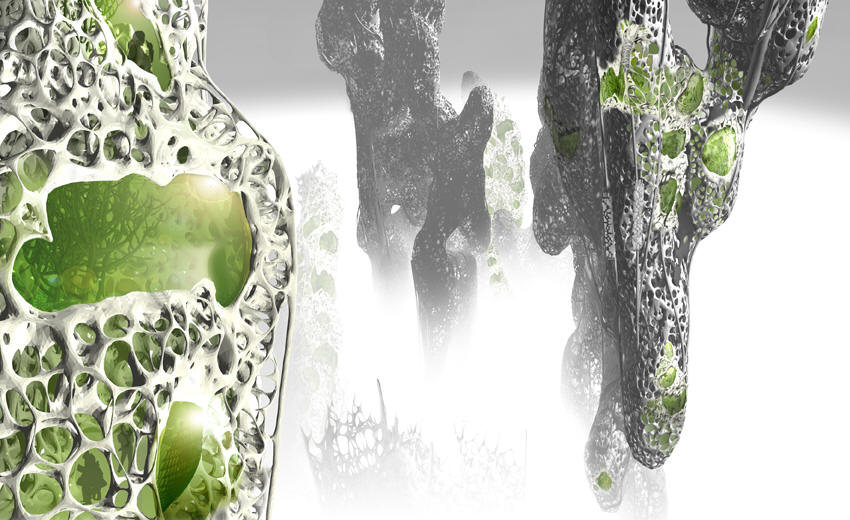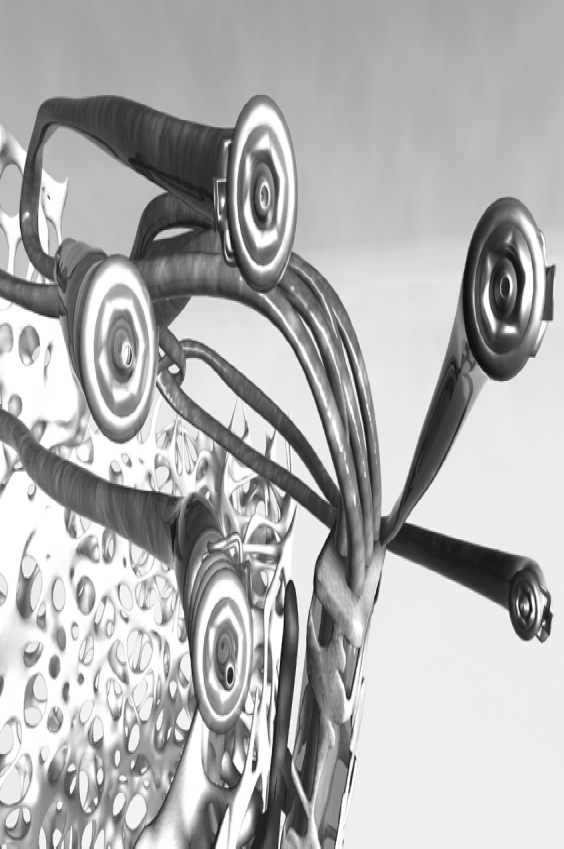Here is a revised version with controls to change variables so that everyone can have a bit of a play.
I have added the potential to set a minimum time that cells must be off before they can be turned on by neighbouring cells being on. This can be used to break the endless cycle and makes responses and interactions from simultaneous pressure sensor inputs at opposite sides of the board more legible. Unfortunately pressure sensor inputs can not be communicated to neighbouring cells that are serving a minimum time off (this is possible to code, but our physical communication setup can not differentiate the cause of neighbouring cells' lights being on). There is also then the potential to set a maximum time that cells can be off before they randomly turn themselves on.
I am not sure what the optimum arrangement is for our installation, and if it would be interesting or too unintelligible for each tile to have individual settings. So keep playing!
Monday, May 30, 2011
Sunday, May 29, 2011
D, I & E Tile Processing Mockup
Here is a quick Processing mockup of our current tile arrangement to demonstrate that lights are communicated in circles. I have also tested some alternative arrangements that produce various other emergent patterns, such as diagonal stripes, by communicating between cells within tiles. All of the arrangements produce endless loops from a single pressure sensor input, but unfortunately in all of the arrangements multiple pressure sensor inputs produce either no legible response or fairly uninteresting interactions.
Controls:
mouse click = pressure sensor input / footstep (to begin)
key q = turn all lights off
key 1 = only neighbouring tiles (current arrangement)
key 2 = neighbouring tiles plus internal cells clockwise
key 3 = neighbouring tiles plus internal cells anti-clockwise
key 4 = neighbouring tiles plus internal cells diagonal
key 5 = neighbouring tiles plus all internal cells
key 6 = neighbouring tiles plus internal cells horizontal
key 7 = neighbouring tiles plus internal cells vertical
Controls:
mouse click = pressure sensor input / footstep (to begin)
key q = turn all lights off
key 1 = only neighbouring tiles (current arrangement)
key 2 = neighbouring tiles plus internal cells clockwise
key 3 = neighbouring tiles plus internal cells anti-clockwise
key 4 = neighbouring tiles plus internal cells diagonal
key 5 = neighbouring tiles plus all internal cells
key 6 = neighbouring tiles plus internal cells horizontal
key 7 = neighbouring tiles plus internal cells vertical
Labels:
8200,
interactive,
interface,
self organisation
Friday, May 27, 2011
D, I & E Reflection
A very big thank you to Stephen Barrass. I very much value the intensive delivery mode of the Digital Design technology units where I feel like I can quickly progress by implementing and then expanding upon learning immediately - before it can be forgotten and then require recapping as in other potential delivery modes. As with previous Digital Design units, Design, Interaction & Environment has opened up a whole new world.
I have never before played with electronics or microprocessors, let alone felt audacious enough to attempt an interactive installation. Of course with any newly learned skills I will need to keep practicing, and it can sometimes be difficult to find the initiative to do this - however I believe that the rapid progression through this unit will now make it more likely that I have the confidence to attempt a project of complexity sufficient to be inspiring. In fact, if I have time, I would like to set up an interactive installation for the my end of year architecture graduating exhibition, which tends to be well attended and a bit of a party.
A particularly appreciated learning experience I think was the production of an installation, which in many ways was a 'real' project. Group work can be very stimulating, but can in a University situation be more often than in a workplace challenging because of unclear roles, lack of (or competing) leadership and group members who don't pull their weight. Thankfully this unit, as a whole of class group project led and facilitated by Stephen, proved to be very productive, and group members who had diverse backgrounds were able to contribute in different ways.
The best bit of the realness of this project was that Stephen left in all the messy bits: we were able to develop a design direction collectively, which is not the easiest processes; we had to shop for the components and materials, which were not always available meaning that we had to adapt the design; we had to investigate and learn new fabrication technologies; and ultimately we ran out of time to finish within the intensive class time! All wonderful lessons in production.
So through this unit I learnt some technical skills like constructing simple electronic circuits and drawing circuit diagrams, and working with various potentiometers and a microprocessor. I also gained great confidence in the adaptability of my programming, particularly in learning Arduino code, which is slightly different to Processing, and in figuring out how to make a library when I was stuck trying to implement classes.
More importantly perhaps were considerations of pertinent content, meaningful interaction, and legible interfaces and environmental responses in the design of installations. Although we were only able to include in our project some of these design and theory ideas, and perhaps in a fairly limited way, I found the class discussion on background readings and research for project proposals most engaging and worthy of expansion in future classes.
I am looking forward to continuing to work on our installation over the next couple of months. I hope that it can still be somewhat collectively curatable - that is I think that more than one person will be able to fit on the tiles at the same time and so suggest that a focus should be interaction between responses to multiple footfalls.
The theme of exploring self organisation is also something that I have had an ongoing interest in. I like very much the tactility of seeing and interacting with self organising systems that are rendered outside of the computer screen.
Taking research at the intersection of self organising systems, architecture and physical computing to a conceptual extreme are R&Sie(n), whose project 'I've heard about' for example envisions an architecture not centrally controlled, self constructed and continually grown and adapted, by landscape secreting 'Viabs' which respond to local conditions including chemical emissions data of it's human inhabitants. This biostructure no longer seems quite so futuristic.
I have never before played with electronics or microprocessors, let alone felt audacious enough to attempt an interactive installation. Of course with any newly learned skills I will need to keep practicing, and it can sometimes be difficult to find the initiative to do this - however I believe that the rapid progression through this unit will now make it more likely that I have the confidence to attempt a project of complexity sufficient to be inspiring. In fact, if I have time, I would like to set up an interactive installation for the my end of year architecture graduating exhibition, which tends to be well attended and a bit of a party.
A particularly appreciated learning experience I think was the production of an installation, which in many ways was a 'real' project. Group work can be very stimulating, but can in a University situation be more often than in a workplace challenging because of unclear roles, lack of (or competing) leadership and group members who don't pull their weight. Thankfully this unit, as a whole of class group project led and facilitated by Stephen, proved to be very productive, and group members who had diverse backgrounds were able to contribute in different ways.
The best bit of the realness of this project was that Stephen left in all the messy bits: we were able to develop a design direction collectively, which is not the easiest processes; we had to shop for the components and materials, which were not always available meaning that we had to adapt the design; we had to investigate and learn new fabrication technologies; and ultimately we ran out of time to finish within the intensive class time! All wonderful lessons in production.
So through this unit I learnt some technical skills like constructing simple electronic circuits and drawing circuit diagrams, and working with various potentiometers and a microprocessor. I also gained great confidence in the adaptability of my programming, particularly in learning Arduino code, which is slightly different to Processing, and in figuring out how to make a library when I was stuck trying to implement classes.
More importantly perhaps were considerations of pertinent content, meaningful interaction, and legible interfaces and environmental responses in the design of installations. Although we were only able to include in our project some of these design and theory ideas, and perhaps in a fairly limited way, I found the class discussion on background readings and research for project proposals most engaging and worthy of expansion in future classes.
I am looking forward to continuing to work on our installation over the next couple of months. I hope that it can still be somewhat collectively curatable - that is I think that more than one person will be able to fit on the tiles at the same time and so suggest that a focus should be interaction between responses to multiple footfalls.
The theme of exploring self organisation is also something that I have had an ongoing interest in. I like very much the tactility of seeing and interacting with self organising systems that are rendered outside of the computer screen.
 |
| R&Sie(n) 'I've heard about' |
 |
| R&Sie(n) 'I've heard about' |
Labels:
8200,
art,
biomimetics,
digital architecture,
interactive,
self organisation
Subscribe to:
Comments (Atom)